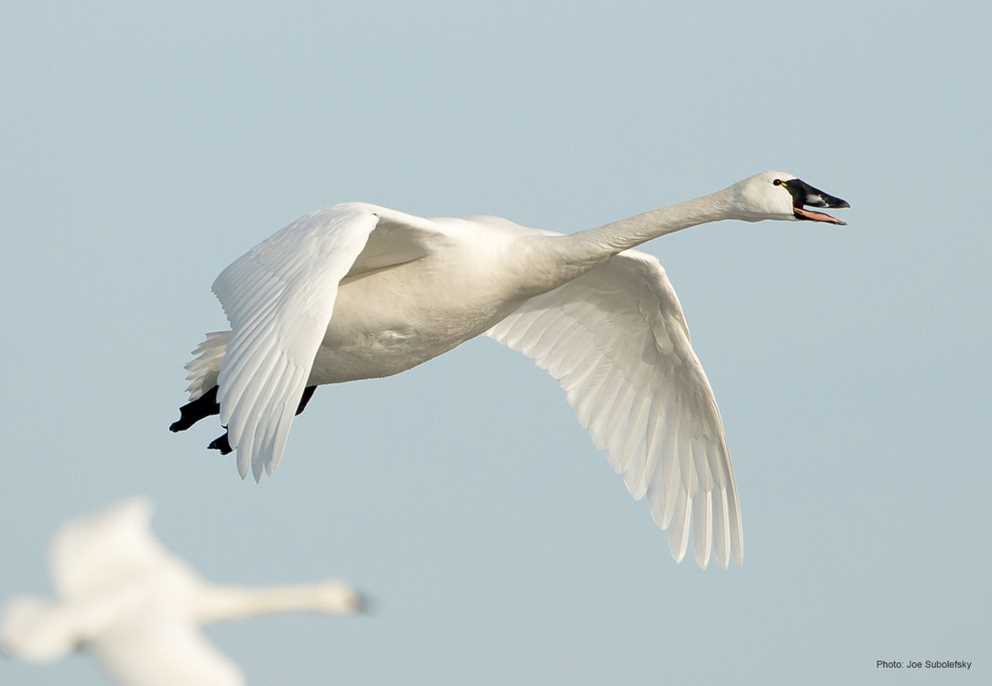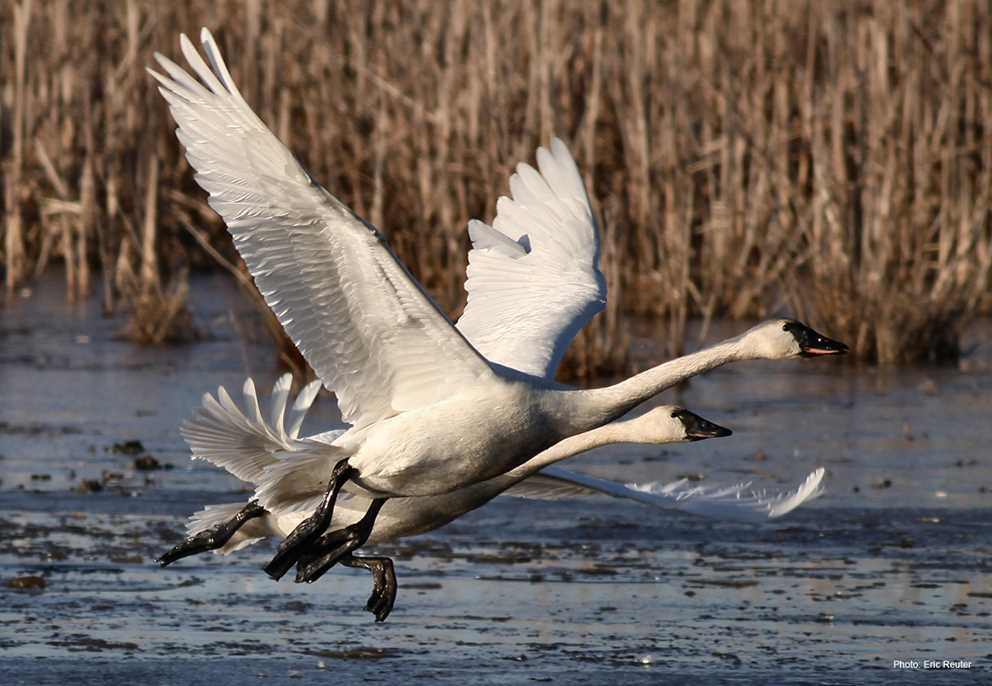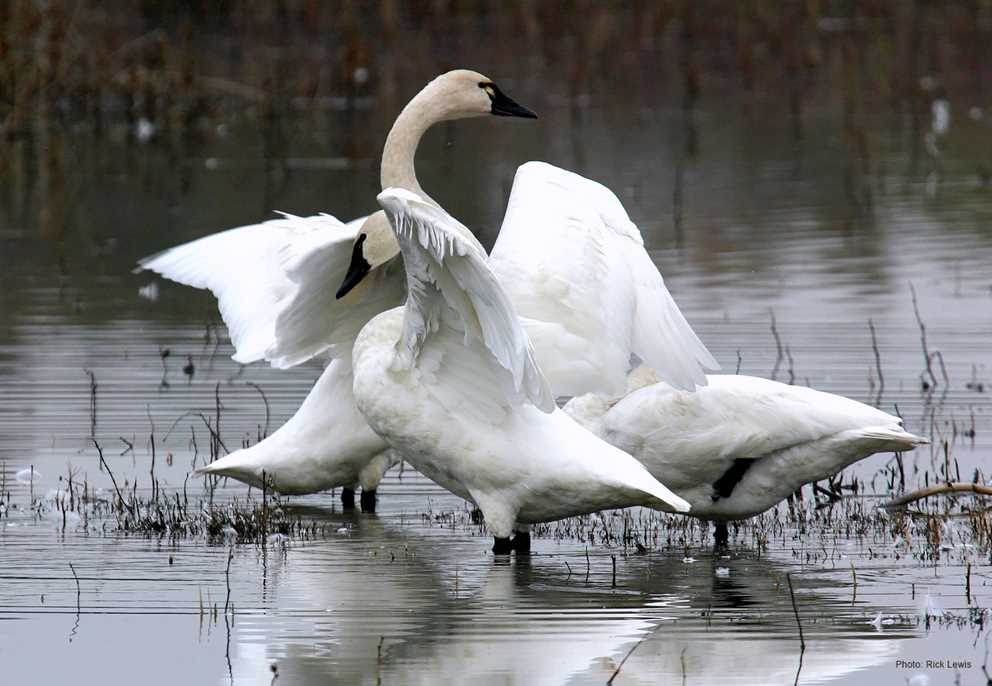Overview
The Tundra Swan has a circumpolar distribution with breeding populations in both North America and Asia. It is the most numerous and widespread species of swan in North America. Their breeding range in North America includes Arctic and sub-Arctic tundra from the Aleutian Islands to Baffin Island. There are two populations in North America, the western population that occurs only in Alaska, and the eastern population. Wintering tundra swans are primarily found in coastal estuarine areas of the Pacific and mid-Atlantic Coasts, but some birds in some years may also winter in coastal Lake Erie, and larger wetlands of the Intermountain West.
Adult Tundra Swans are large, all white, and the sexes are identical, while immature birds are brownish gray. The bill of adults is black, and most birds show a yellow lore that is variable in size. Their bills are slightly shorter and show a slight concave curvature from the forehead to tip that helps separate them from the similar Trumpeter Swan. Immature birds will be brownish gray, with pinkish-gray bills and feet.
Description
Key Identification Features
- The plumage of adult Tundra Swans is white, while the bill, tarsi, and feet are black.
- The bill of most Tundra Swans has yellow lores that varies in amount. The bill is slightly shorter and slightly convex from forehead to tip compared to the similar Trumpeter Swan, and may show a salmon to orangish streak on the upper mandible.
- Immatures are brownish-gray overall, with a pinkish-gray, or sometimes black bill, the tarsi are pinkish gray.
Male/Female Average Length and Weight
- Mass: Male 14.1–17.6 lbs.; Female 12.3–15.4 lbs.
- Wing length: Male 21.2 in.; Female 20.9 in.
Male and Female Identification
- Alternate (Breeding) and Basic Plumage: Both adult plumages of both sexes are identical. White plumage, with slightly convex black bills with a yellow lore patch, the black extending and forming a finer point at the eye. Feet are black. Immature birds are brownish gray, with pinkish bills, and pinkish-gray feet.
In-Flight Identification
- Tundra Swans are very large and white and will hold their necks straight during takeoff and the first part of their flight.
Vocalizations
- Very vocal, higher pitched than Trumpeter Swans, adults make a goose-like, 1-3 syllable “oo” or “ou.” Immature call is higher pitched than adults.
Similar Species
- Trumpeter Swans: Adults may be easily confused with the Trumpeter Swan in North America. Compared to Trumpeter Swans, Tundra Swans are slightly smaller overall, and will have a shorter, slightly convex bill with a yellow lore spot, and the black extending from the bill to the eye is narrower and pointier. Calls also distinguish the two species.
Habitat Preferences
- Breeding: Tundra Swans nest in Arctic tundra lakes, ponds, and pools, primarily in coastal areas though occasionally inland to the tree line. They prefer wetlands with substantial emergent or floating vegetation upon which they feed.
- Migration and Wintering: In migration and winter, they use marshes and lakes with abundant aquatic vegetation and also make extensive use of agricultural fields for foraging.
Foraging Habits and Diet
- Tundra Swans are predominantly vegetarian with a diet of more than 95% submerged plant material. Vegetation consumed includes tubers, roots, stems, and leaves of various emergent and aquatic plants. In migration and winter, Tundra Swans have adapted to use agricultural fields to feed on waste grain and winter cereal crops.
Breeding Habits
- Monogamy: Tundra Swans maintain monogamous, lifelong pair bonds.
- Nest Locations: Nest initiation dates vary with latitude and ice conditions, but usually is May–June. The nest is a large mound of plant material near large waterbodies or on islands that may take 4 to 9 days to construct.
- Clutch Size: 3 to 5 eggs. The eggs are creamy white, elliptical-ovate, and average 4.2 by 2.7 in. The incubation period is 31–32 days, with females performing more of the incubation duties than males, but both participate. Males provide nest defense.
Migration & Distribution
- Fall Migration: Eastern population Tundra Swans depart breeding grounds in late September, arrive on staging areas in the Dakotas and Prairie Canada in October, and usually arrive on wintering areas in November. Western population birds depart Alaska in September and arrive in wintering areas (name some of the wintering areas?) in October or November.
- Spring Migration: Spring migration begins as early as February and continues through April, with arrival on breeding areas usually coincident with ice out in May.

Conservation Status
- IUCN Status: Least Concern
- Population Status: The population is stable to increasing throughout their range, and as of 2000 was estimated at 170,000 for eastern and western populations combined. The western population reached 100,000 birds in 2000.
- Conservation Concerns: The primary threats include wetland loss, climate change, and lead poisoning.
- Conservation Focus: Conservation efforts focus on protecting and restoring habitat, as well as reducing the likelihood of lead shot consumption to limit poisoning.
Harvest Information
- Hunting of Tundra Swans is highly regulated by permit only in the states of Alaska, Montana, Nevada, North Dakota, South Dakota, Utah, New Jersey, North Carolina, and Virginia. Approximately 6,000–7,000 permits are issued annually, resulting in a harvest of 2,300–2,800 birds.




